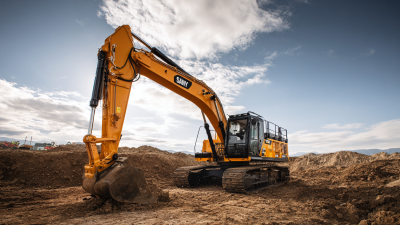Leave Your Message
- Phone
- E-mail
- Whatsapp
In the rapidly evolving construction industry, the integration of data-driven solutions has emerged as a game-changer, significantly enhancing operational efficiency and project outcomes. Sany Equipment, a leading player in heavy machinery manufacturing, is at the forefront of this transformation, harnessing innovative technologies to revolutionize construction practices. According to a recent report by McKinsey & Company, construction productivity has lagged behind other industries, with an estimated improvement potential of 50% through digital advancements and data utilization. This statistic underscores the urgent need for construction companies to adopt smart, data-centric approaches.

Sany Equipment is leveraging advanced analytics, machine learning, and the Internet of Things (IoT) to optimize machinery performance and streamline workflows. By implementing these innovations, Sany Equipment is not only improving the efficiency of construction operations but also reducing costs and minimizing project delays. The World Economic Forum highlights that the adoption of digital tools in construction could lead to cost savings of up to $1.6 trillion globally by 2025. As we explore the innovative solutions developed by Sany Equipment, it is essential to analyze how these technologies are reshaping the landscape of construction, enabling stakeholders to achieve greater efficiency, safety, and sustainability in their projects.
Sany Equipment is at the forefront of revolutionizing construction efficiency through the implementation of smart data systems. By harnessing advanced data analytics, Sany enhances project management and operational performance, leading to significant improvements in productivity. According to a report by McKinsey, the construction industry could improve productivity by up to 15% through the adoption of data-driven technologies. Sany's commitment to integrating innovative solutions aligns with this potential, demonstrating how effective use of data can streamline processes and minimize delays.
One of the key innovations introduced by Sany is the real-time monitoring of equipment health and performance, which not only reduces downtime but also optimizes resource allocation. A study by the World Economic Forum suggests that leveraging analytics and IoT can lead to a 5-10% reduction in operational costs in construction. Sany's smart data systems enable contractors to anticipate maintenance needs and avoid costly interruptions, showcasing the tangible benefits of data-driven solutions in the industry. Through these advancements, Sany is setting a benchmark for others to follow, proving that the future of construction lies in intelligent data utilization.
The integration of IoT in construction equipment monitoring and predictive maintenance is revolutionizing the industry. By leveraging data-driven solutions, companies can now track the performance and health of machinery in real time, allowing for proactive maintenance strategies. This not only minimizes downtime but also extends the lifespan of equipment, resulting in significant cost savings.
Tips: When implementing IoT solutions, ensure that your team is trained to analyze and interpret the data generated. Utilize cloud-based platforms for data management to facilitate seamless access to insights and streamline operations.
The promise of predictive maintenance lies in its ability to identify potential failures before they occur. Advanced sensors can monitor various parameters of equipment performance, enabling timely interventions that prevent costly breakdowns. As IoT technology continues to evolve, the construction industry stands to benefit greatly from enhanced operational efficiency and resource management.
Tips: Consider investing in a robust IoT gateway that supports various communication protocols to enable smoother integration with your existing systems. Regularly update your software to harness the latest advancements in AI and machine learning for better predictive analysis.
Sany Equipment is at the forefront of integrating machine learning solutions into construction practices, revolutionizing how projects are managed and executed. By leveraging data-driven strategies, Sany is streamlining operations and significantly reducing costs. Advanced analytics allow construction teams to predict project timelines and resource needs with greater accuracy, ultimately leading to more efficient use of materials and labor. This not only enhances productivity but also minimizes the risk of budget overruns, which is a common issue in the construction industry.
**Tip:** To maximize the benefits of machine learning solutions, construction firms should invest in training their workforce on data interpretation and analysis. An informed team can make better decisions based on the insights generated by advanced technologies.
Furthermore, Sany's innovative approach includes real-time tracking of machinery performance and site conditions. By continuously monitoring these variables, Sany can provide actionable recommendations that help mitigate downtime and optimize equipment usage. This proactive stance contributes to lower operational costs and extends the lifespan of machinery as maintenance can be anticipated rather than being reactive.
**Tip:** Companies should consider adopting a centralized data platform to collect and analyze inputs from various sources in real time. This can lead to more informed decision-making and better alignment of project goals with operational capabilities.
| Parameter | Value | Unit | Notes |
|---|---|---|---|
| Average Cost Reduction | 15 | % | Due to machine learning optimizations |
| Time Savings | 20 | hours/week | On average per project |
| Improvement in Equipment Utilization | 30 | % | Optimized scheduling via data analysis |
| Prediction Accuracy of Maintenance Needs | 90 | % | Leveraging AI analytics |
| Reduction in Equipment Downtime | 25 | % | Through predictive maintenance |
The integration of big data into construction project management is revolutionizing efficiency and timeliness in the industry. By harnessing vast amounts of data, construction companies can make informed decisions that enhance project outcomes. Advanced analytics allows managers to predict project timelines more accurately, optimizing resource allocation and reducing delays. This proactive approach not only streamlines operations but also improves overall project profitability.
As digital transformation gains momentum in the construction sector, organizations are increasingly adopting specialized software solutions designed for task scheduling and real-time monitoring. These tools enable teams to collaborate effectively, providing instant access to project updates and allowing for swift adjustments as challenges arise. By embracing data-driven methodologies, construction firms can mitigate risks and enhance their agility, ultimately leading to improved project management and successful project delivery.
This chart illustrates the improvement in construction efficiency over five years as various data-driven solutions are integrated into project management. The efficiency is measured by the percentage increase in on-time project completions, reflecting the transformative effects of big data on the construction industry.
The integration of innovative technology in the construction industry is transforming operational efficiency while also addressing pressing environmental concerns. Recent advancements, such as multifunctional construction robots, are paving the way for enhanced sustainability in construction operations. These robots not only perform multiple functions—such as plastering, grinding, and spraying—but also help mitigate labor shortages caused by an aging workforce. By employing these machines, construction projects can be completed at a faster pace without compromising safety or quality.
Furthermore, the strategic use of these innovations aligns with the industry's goals for environmental sustainability. With robots handling labor-intensive tasks, there is a reduction in waste generation and resource consumption, contributing to a more eco-friendly construction process. This shift not only improves productivity but also fosters a safer work environment, as automated systems can perform dangerous tasks that would traditionally require human labor. The ongoing adoption of such technologies signifies a crucial movement towards a more sustainable and efficient construction industry.






